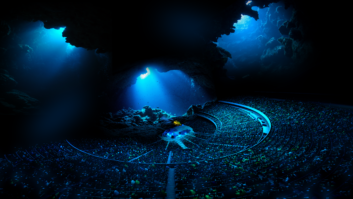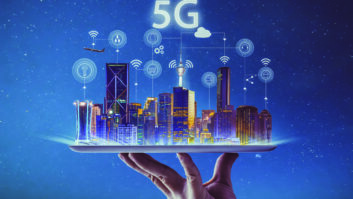
If I told you that the first head-mounted display for immersive simulation applications was developed in 1968, the likelihood is you’d be surprised.
Immersive technologies have been around for some time now, but while they’ve developed at a steady rate, it’s only recently that we’ve witnessed a real boom in the industry. Now VR and AR are acronyms accepted into common parlance, thanks in part to their adoption by the gaming community and wildly popular mobile applications, such as Pokémon Go.
Virtual and augmented reality hold the potential to revolutionise the way we create and consume content, either by augmenting our daily lives or by truly immersing us in experiences.
However, further progress and adoption of the technology has been hampered by the limited latency, capacity and efficiency of current mobile networks. These have proved particular barriers when it comes to the development of simultaneous 360° VR experiences. Right now, we can all enjoy being immersed in a different world – but it’s incredibly difficult to share it with anyone else.
This will change with the rollout of 5G. The next-generation mobile network will transform the way we experience immersive content, providing the traffic and network capacity required to bring the technology to mass audiences across the world and provide unprecedented access to large-scale cultural events.
Preparing for 5G
As CEO of a UK-based immersive content business, I knew that the widespread rollout of 5G would have an astronomical impact on my business. However, knowing something is coming and having a fully-fledged plan for its arrival are two very different things. Like many of my peers, I struggled to find the bandwidth or skills internally to fully prepare for 5G’s arrival.
“The 5G roadmap is complex, making layering a product roadmap on top of this even more difficult”
And getting ready to capitalise on the opportunities promised by a next-generation network is no mean feat. The 5G roadmap is complex, making layering a product roadmap on top of this even more difficult.
In need of a hand, we turned to the UK’s digital innovation centre, Digital Catapult, who offered support through several initiatives. These included the 5G Testbed Acceleration Programme, the Future of Training Showcase, the 5G-Victori (Horizon 2020) Project and the 5G Smart Tourism Project.
Paving the way
Taking part in the 5G Smart Tourism showcase proved to be a pivotal moment for Mativision. This enabled us to step away from our comfort zone in the music industry, and look at how immersive content, supported by 5G, could benefit tourism.
One of 19 companies selected for the project, we pioneered the integration of 5G technology with VR to develop a 4K 360° VR experience of Bristol Pride Day and Harbour Festival. This could be played simultaneously through multiple VR devices, revealing 5G’s potential to overcome current barriers to sharing immersive content in sync. When previously doing commercial 360° livestreams, the viewer would experience a delay of 45 seconds from the moment of action to the moment it appeared in the VR headset. However, we managed to reduce this at the 5G Smart Tourism Showcase, getting the delay down to just four seconds. This is remarkable; it is comparable with the typical delay of 1-2 seconds seen on big screens in stadiums. Very soon, using the technologies available at the Future Networks Lab and relying on the expertise of the team there, we’ll be able to get the delay down to just milliseconds.
This is just one example of how immersive content, supported by 5G, can democratise cultural experiences. Mativision has been successfully live streaming high-profile concerts and other events – like MTV’s EMAs) in 360° for more than a decade. However, 5G’s low latency will now allow us to deliver a VR streaming experience shot on-location with a short enough delay (tens of milliseconds) to offer off-site viewers an incredible immersive experience, something like an immersive ‘second screen’.
Such developments will also permit unprecedented access to events, providing people who are physically unable to attend with an immersive experience of the event far closer to the real thing than watching it on television.
Immersive training
Looking beyond tourism, the rollout of 5G will fast-track the use of immersive content in numerous sectors and situations. Indeed, VR is already being used in training to simulate high-stress scenarios, such as medical emergencies or landing a plane. Organisations that deploy the technology in this way stand to benefit from 5G’s rollout, as multiple people will be able to experience scenarios simultaneously. Team-based synced training will become feasible without the need for excessive infrastructures. This will save organisations time and help them to better assess and compare the performance of participants.
The effectiveness of immersive training means that content development for this purpose is set to become increasingly competitive. This was palpable at Digital Catapult’s Future of Training showcase, where we exhibited numerous 5G-enabled platform solutions to industry and academics alongside five other companies.
What’s next for immersive content?
Initiatives such as the 5G Smart Tourism Project and Future of Training showcase are key for the development of the immersive content industry in the UK. These offer participants invaluable exposure to new sectors, networks and expertise, enabling businesses like Mativision to test their boundaries and realise their full potential. We’re committed to staying at the forefront of immersive content development, and this depends on fully understanding the next-generation network and what it means for us. Thanks to our involvement in the initiatives discussed, and the support of our partners, we now do.







